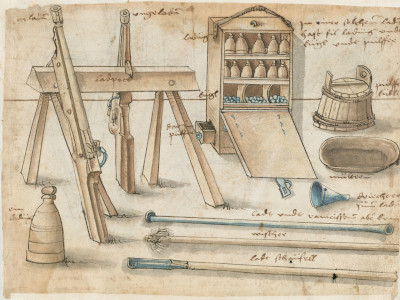
The use of firearms requires a certain basic equipment of accessories, which is absolutely necessary for loading the rifle.
Other pieces of equipment make it easier for the shooter to handle the rifle, such as powder measures, shot gauges, scabbards, powder horns, bags or weapon chests. For example, a good overview is provided by archaeological finds of several sets of extensive accessories, found in the wreck of the Mary Rose, which sank off Portsmouth in 1545.1) Two illustrations from a fragment of a master gunners book attributed to Johannes Formschneider, which shows the almost complete equipment for marksmen rifles, are a most valuable source of images.2)
Ramrod
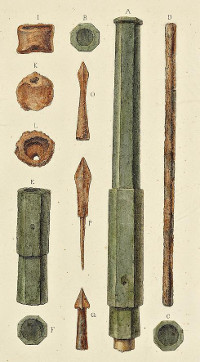 One of the most important rifle accessories is the ramrod, which is used to compress the powder charge and place the bullet on the charge. Historical sources3) indicate that they were often made of iron and probably also of wood. For example, they are mentioned several times in the year 1412 in the document books of the city of Hildesheim as "stempele": „… 2 yserne stempele, darmen de bussen mede ladet”.4) (… 2 iron stamps to load the guns). According to the current German laws, ramrods must be made of a non-sparking material, so iron is out, and we have chosen wooden and a bronze ramrod, as they are also historically conceivable.
One of the most important rifle accessories is the ramrod, which is used to compress the powder charge and place the bullet on the charge. Historical sources3) indicate that they were often made of iron and probably also of wood. For example, they are mentioned several times in the year 1412 in the document books of the city of Hildesheim as "stempele": „… 2 yserne stempele, darmen de bussen mede ladet”.4) (… 2 iron stamps to load the guns). According to the current German laws, ramrods must be made of a non-sparking material, so iron is out, and we have chosen wooden and a bronze ramrod, as they are also historically conceivable.
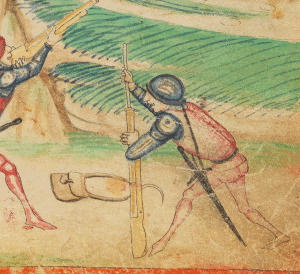
Diebold Schilling - Amtliche Berner Chronik 1478-1483
Shot Gauge
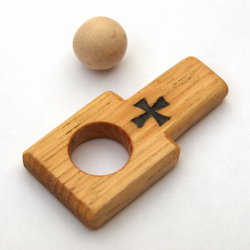 Early rifles did not yet have uniform standardised calibres. Every rifle in the arsenals had its own calibre due to the manufacturing process. It was not until the 16th century that rifles with uniform calibres were produced. The individual calibres made it necessary to provide each rifle with its own accessories and ammunition. Shot gauges were used to determine the required ball and sabot sizes. These could be made of iron, like the examples called "ring zun puchsen" (ring for the guns) from the Innsbruck armoury inventory of 1540-15605), or they were made of wood like the ones depicted in the Kriegstechnische Bilderhandschriften KHM Vienna P 5014 of 1440-14506) and the Zentralbibliothek Zurich Ms Rh hist 34 of 1420-14407) The first reference to rifles with a uniformly standardised calibre comes from a document relating to the Armagnac campaign, according to which the city of Speyer orderd in Nuremberg in 1444: "eynhundert oder zwey guter hantbochssen, die in eyner forme weren und alle glich kloezer schuszen" (one hundred and two good guns in one shape and shooting the same shots.8) When we made our ball gauge, we were guided by the Viennese manuscript.6) In order to ensure that the ball gauge belongs to the matching rifle, we have marked it with the rifle mark, as documented in armoury inventories9) or books on military technology10).
Early rifles did not yet have uniform standardised calibres. Every rifle in the arsenals had its own calibre due to the manufacturing process. It was not until the 16th century that rifles with uniform calibres were produced. The individual calibres made it necessary to provide each rifle with its own accessories and ammunition. Shot gauges were used to determine the required ball and sabot sizes. These could be made of iron, like the examples called "ring zun puchsen" (ring for the guns) from the Innsbruck armoury inventory of 1540-15605), or they were made of wood like the ones depicted in the Kriegstechnische Bilderhandschriften KHM Vienna P 5014 of 1440-14506) and the Zentralbibliothek Zurich Ms Rh hist 34 of 1420-14407) The first reference to rifles with a uniformly standardised calibre comes from a document relating to the Armagnac campaign, according to which the city of Speyer orderd in Nuremberg in 1444: "eynhundert oder zwey guter hantbochssen, die in eyner forme weren und alle glich kloezer schuszen" (one hundred and two good guns in one shape and shooting the same shots.8) When we made our ball gauge, we were guided by the Viennese manuscript.6) In order to ensure that the ball gauge belongs to the matching rifle, we have marked it with the rifle mark, as documented in armoury inventories9) or books on military technology10).
-
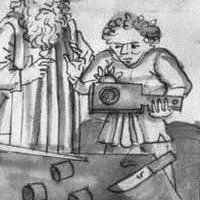
Kriegs vnnd Pixenwerch. Süddeutschland/Österreich 1440-1450. Kunsthistorisches Museum Wien KK 5014, fol. 17r 
Kriegstechnische Bilderhandschrift. Oberrhein ca. 1420-1440. Zentralbibliothek Zürich Ms Rh hist 33B, fol. 35v
Powder Ladl
For loading larger and horizontally aligned guns, powder ladls (loading shovels) are necessary in order to be able to introduce the powder charge directly into the powder chamber. They were used to push the powder charge into the chamber, where it was discharged by rotation. Without loading paddles, a considerable part of the powder would remain in the bore of the rifle. Powder ladls are not necessary for handguns, as they can be erected for loading. In 1412, a documents book of the city of Hildesheim mention the purchase of "... 3 busseken van blecke darmen dat pulver in de pussen mede deyt" for 3 powder pots made of sheet metal with which powder was filled into the rifles.11)
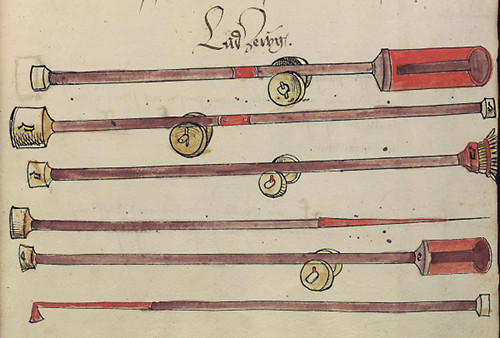
Powder lads, rammers and sponges for cannons. Ulrich Beßnitzer: Landshuter Zeughausinventar 1483, Fol. 10r
Priming Wires
 Priming needles or -wires are primarily used to clear touchholes of encrusted powder residues that clog the ignition hole and prevent safe ignition. In addition, the primig wire is used to clear the ignition hole after a misfire so that new priming powder can be added. An interesting recommendation is given by the master gunner of the Göttingen Codex ms. phil. 63, who suggests to pierce a hole with an awl through the priming hole and the powder charge down to the bottom of the barrel and fill it up with fast-burning priming powder so that the rifle will ignite safely: „… dass du einen pfriemen hast, wenn du die büchse lossbrennen willst. Diesen Pfriemen stoss durch das Weydloch bis auf dem Boden durch das Pulver Alsdann nim das pulvis currasive, welches du bei dir haben musst und saige es dem pfriemen nach und fülle das Weydloch damit an. Dies Losspulver ist sehr heiss und scharf und entzündet das andere Pulver sehr geschwind in der Büchsen, und wenn dies auch verdorben wäre, so hilft dies Zündpulver, dass es lossgehen muss.” (... that you have an awl when you want to fire the rifle. Push the awl through the touchhole to the bottom of the chamber.Then take the pulvis currasive, which you must have with you, and fill the hole with it. This loose powder is very hot and sharp and ignites the other powder in the chamber very quickly, and if this would also be spoiled, this ignition powder helps it to go off.)13)
Priming needles or -wires are primarily used to clear touchholes of encrusted powder residues that clog the ignition hole and prevent safe ignition. In addition, the primig wire is used to clear the ignition hole after a misfire so that new priming powder can be added. An interesting recommendation is given by the master gunner of the Göttingen Codex ms. phil. 63, who suggests to pierce a hole with an awl through the priming hole and the powder charge down to the bottom of the barrel and fill it up with fast-burning priming powder so that the rifle will ignite safely: „… dass du einen pfriemen hast, wenn du die büchse lossbrennen willst. Diesen Pfriemen stoss durch das Weydloch bis auf dem Boden durch das Pulver Alsdann nim das pulvis currasive, welches du bei dir haben musst und saige es dem pfriemen nach und fülle das Weydloch damit an. Dies Losspulver ist sehr heiss und scharf und entzündet das andere Pulver sehr geschwind in der Büchsen, und wenn dies auch verdorben wäre, so hilft dies Zündpulver, dass es lossgehen muss.” (... that you have an awl when you want to fire the rifle. Push the awl through the touchhole to the bottom of the chamber.Then take the pulvis currasive, which you must have with you, and fill the hole with it. This loose powder is very hot and sharp and ignites the other powder in the chamber very quickly, and if this would also be spoiled, this ignition powder helps it to go off.)13)

Several priming wires from Philipp Mönch: Kriegsbuch. Um 1496. UB Heidelberg Cod Pal germ 126, S. 97
A prming wire attached by a small chain fromku Martin Merz: Feuerwerksbuch. Um 1473. BSB Cgm 599 fol 10r
Gunner's Scale
If a master gunner had to operate several guns, he was faced with the problem that each gun had an individual calibre and required a different amount of charge. Consequently, the appropriate projectiles had to be selected for each gun and the corresponding charge calculated according to the projectile material (stone, iron or lead) and shooting distance. To solve this problem, the master gunner of the Dauphin, which sank off the harbour of Saint-Malo in 1704, had a gun gauge made of boxwood, with the help of which he could easily read off all the necessary data for each of his guns. This multifunctional device has markings on all sides. The stepped side is used to determine the calibres of the guns, and the adjoining tables list the types of guns as well as the various charge and bullet weights in pounds in a matrix. A scale in inches is cut into the lower edge. The 14x8 IC mark on the device indicates that it was made in 1648 by John Chatfield, an English manufacturer of scientific instruments.14)
Although this device falls outside the time frame discussed here, it should nevertheless be mentioned here because of its innovative character.

Ballscrew and Wad Hook

Ballscrews or wad hooks are needed to unload rifles that cannot be fired any more after misfiring. Ballscrews have a self-tapping screw-shaped tip, similar to modern chipboard screws, which is screwed into the lead ball. With it, the ball can then be pulled out of the barrel and the powder charge removed. The wadding and sticky powder residue can then be removed with a corkscrew-like wad hook. According to Bernhard Rathgen13), such a scraper can already be found in the Hildesheim document books from the year 1421 as: "… vor eyn bor to den büssen …” (… for a drill for the rifles).15)

Ballscres, wad kooks, ramrods, spinges and other accessories for arquebuses from Johannes Formschneider: Büchsenmeisterbuch. WLB Cod. milit. qt. 31, Fol. 6v.2)
Cleaning Rod, Sponge

After firing, it is important to clean and wipe out the barrel thoroughly because burnt black powder, together with atmospheric oxygen, forms aggressive acids that attack the gun metal. In addition, encrusted powder residues are difficult to remove. After firing in quick succession, it is important, especially with larger guns, to wash out the chamber and bore so that glowing powder residues do not ignite the next charge while being loaded. Cleaning rotds with a brush end were used for cleaning.
Artillery Chest
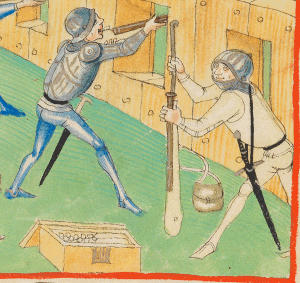 To store and keep accessories and bullets ready at the place of action, there were artillery chests. These chests usually had different compartments for the accessories, bullets and powder supplies or Hultzein Ladungen, small wooden containers with single powder loads. Some of these compartments had additional lids to cover them. Eyb zum Hartenstein's war book suggests that for each rifle or at least for each gun there were individual chests for their accessories. These chests wwere marked with the rifle mark for identification.10)
To store and keep accessories and bullets ready at the place of action, there were artillery chests. These chests usually had different compartments for the accessories, bullets and powder supplies or Hultzein Ladungen, small wooden containers with single powder loads. Some of these compartments had additional lids to cover them. Eyb zum Hartenstein's war book suggests that for each rifle or at least for each gun there were individual chests for their accessories. These chests wwere marked with the rifle mark for identification.10)
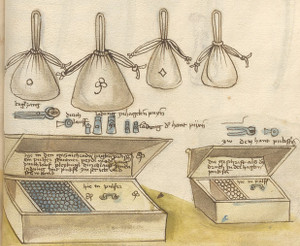
Two chests for two handguns, from Ludwig von Eyb zum Hartenstein: Kriegsbuch, ca. 1500, Fol. 276r
References
- Hildred (2010): pp.. 401–503
- Formschneider: Büchsenmeisterbuch (Fragment).WLB Cod. milit. qt. 31.
- Hefner, von Wolf (1850); Schilling (1474-1485); etc.
- Doebner (1897): pp. 454, 546, here 457
- Freysleben (1459-1500): Fol. 20r
- Kriegs vnnd Pixenwerch (1440-1450): Fol. 17r
- Kriegstechnische Bilderhandschrift (1420-1440): Fol. 35v
- Rathgen (1929): p. 88
- Beßnitzer (1486): Fol. 10r
- Eyb zum Hartenstein (1500): Fol. 276r
- Doebner (1897): 9. 454
- Bellifortis (1402-1405) UB Göttingen Cod. ms. phil. 63
- Rathgen(1929): p. 303, table 21
- The gunner's scale from the Dauphine auf The Saint-Malo Shipwrecks
- Doebner (1897): p. 189
